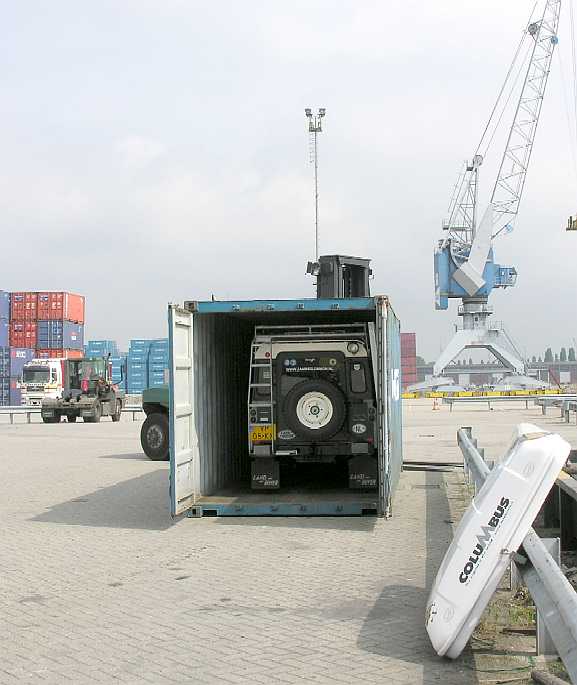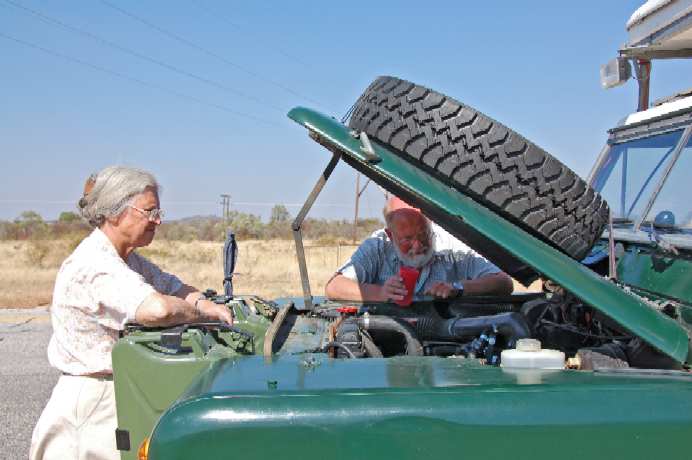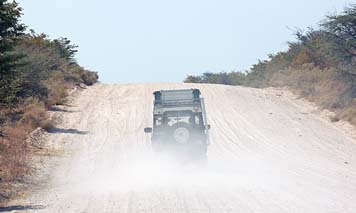

Road Adventures - Wa Bashasha Log - Part 1
Now we are halfway, it is a good time to reflect on Wa Bashasha’s adventures for the first time. Before I continue, let me say that she has done admirably well so far. The only time we did not really succeed to make her run, was when she came out of the container after having been at sea for a month. Maybe that container is a good point to start.
CONTAINER TRANSPORT
Wa Bashasha was shipped - in a 20 ft container - from Rotterdam to Cape Town by Van den Meerendonk in Ridderkerk. Looking back on the whole procedure, we are far from satisfied with Van den Meerendonk. To begin with, and due to the incomplete and late information we received from them, we arrived in Cape Town 2 weeks before Wa Bashasha. Then, the car was badly damaged during the voyage. Its axles had not been secured tight enough and hence the car bashed repeatedly against the right hand wall of the container. If we would have brought the car to a panel beater, the costs would have been in the order of Euros 2500. As it is, we left her battered. Last, but not least, a heavy expedition car with leave springs, should only have been shipped after taking the weight off the springs by putting stands under the car. According to our South African specialist, experienced shippers now. Van den Meerendonk did not. Since the container was not high enough for the car with the roof tent on top, we had to take the roof tent off. The tent was stowed next to the car, against the wall of the container, without any padding at the side or under it. Hence the roof tent suffered considerable damage. So, if you ship your car to your overland starting point:
Better still, of course, don’t ship your car to Cape Town but drive it down!

FUEL PUMP, FUEL SWITCH AND FUEL LINES
It is somewhat of a disappointment, to put it mildly, when you cannot drive your car out of a container and the custom ware house. In our case, a faulty petrol switch (leaking and drawing air) was the cause and it could probably not have been avoided. Soon after we hit the road, however, it became obvious that the car had a petrol supply problem when climbing steep hills and when idling in towns. By trial and error, we found the remedy: switch off the engine and wait for half an hour or more to have an extra lunch. Not really convenient when you are halfway a slope or in front of a green traffic light. In a garage in Windhoek, we got the advise to put a damp cloth on the fuel pump and to drip cold water on it.

It always helped and after only 5 minutes we could start the car again. Still, not really convenient either. In Namibia, I re-located the front fuel lines to keep them as far away as possible from the front engine block. To little avail. Only in Bagamoyo, in Tanzania, I suddenly saw that the main fuel line, coming from the fuel pump, was attached with a brass bracket directly to the lower engine block. When I put my finger on it, I almost had a blister. I disconnected the fuel line and took it away from the lower engine block. Since then we had no more fuel supply problems. So, when you prepare a Series III for an Africa expedition, make sure that the fuel lines nowhere com near to the engine block!
SPRINGS, SHOCKS AND AIRCUSHIONS
In Holland, I should have stuck to my defences. When we bought the car, I had the heavy duty leave springs of our one-tonne ex-MOD, front and rear, exchanged for brand new ones. The shocks were exchanged too. A rather costly exercise. After some four months, the rear springs started sagging. According to our garage, Jansen in Oisterwijk, the springs were not properly hardened in the factory and they proposed to mount new parabolic springs. Without much extra costs for us, for that matter. The parabolic springs were to be strong too, but with much more comfort. With respect to the comfort, they were right. The car almost drove like a limousine. When we started loading her – roof rack, roof tent, roof box, water tanks, sand ladders, Engel refrigerator and three 20 kg boxes of spare parts – the rear, however, stood lower than the front. According to Jansen this was no problem: the more you load, the stiffer the parabolic springs become. Against better judgement, I left it at that. In Cape Town, when we had the car in the garage to exchange the faulty petrol switch, all the mechanics gathered around the car and shook their heads. When I asked what was wrong, they expressed their severe doubts with respect to the required stiffness and flexing capacity of the rear parabolic springs. When some guys climbed in the rear, the car even sagged more. A good remedy, according to them, was to install two Firestone aircushions between the chassis and the springs. The aircushions can be inflated from inside the car, either by a compressor or by a suitable hand pump. When the car is fully loaded, more pressure can be applied. When the car is almost empty, you deflate the cushions accordingly. I had not heard of this system, let alone seen it, but after some deliberations we decided to follow their advice. Next afternoon we saw the results: a heavily loaded car that stood level and drove like a dream. By the time we had covered the first 6000 km of severely corrugated dirt roads in Namibia and Botswana and dried out, deeply rutted, clay tracks in the lower Zambezi delta in Mozambique, Mark of Jaba Motors in Cape Town was a popular man with us. Without his aircushions, I would not have managed to get through Moreni and Chobe and to drive from Mopeia to Luabo and back without severe damage to the car. Unfortunately, I sprung one of the cushions on our way out of Mozambique, but that was as much because of an installation error as because of extremely unfavourable driving conditions. Back in Blantyre, in Malawi, Mark of Jaba Motors had two new aircushions flown in within 48 hours after our request. If you travel Africa by car, those are the guys to go to!! In the meantime, I have also discovered a way to better protect the aircushions from rubbing against metal parts underneath the car. If the cushions are still intact after the next 10.000 km, I will send Mark a short description of how to install this protection. By then, hopefully, my invention will be a proven technology.
 DUST
DUST
There is one aspect we did not pay enough attention to when we prepared the car for her Africa crossing: dust! Now, let me say one thing first. It is near impossible to made a Series III waterproof, so dustproof is too high an ambition. We knew this, but still we grossly underestimated the problem. On the first dirt roads in Namibia, we were confronted with Wa Bashasha’s gusto to suck up dust through the petrol tank hatches under both our seats and through the rear door seals. When we hit the first chalk-like desert dust, white dust appeared through every crack, slit and loosened pop-nail.
Now, after three months, we have contained the problem to some extent. I used my last metres of rubber strips to seal the petrol tank hatches and the rear door. The result is not perfect, but at least our vision is no longer impeded by a haze of dust in the car! The gaps in the body work, Series Land Rovers were never “seamlessly” assembled, I filled up with a thick paste made from chalk dust and Botswana toilet paper. You can press the paste in any shape and when dry it is very hard and durable. In short, when you plan to cross Africa in an ex-MOD Land Rover Series III - 2 fuel tanks under each front seat - make bloody sure you first completely seal the two petrol tank hatches. Then, begin sealing all cracks you see under and in the car. Don’t forget to tape the holes in the door locks. At one time, we could see a jet of dust coming out of them!
WINDOWS CLAMPS
The front window is bolted to the steel bulkhead by means of two hardened steel bolts and nuts. Normally, now, you would expect no problems. With a heavy roof rack, a roof tent, a luggage box, two water tanks and roads no one in Europe can imagine, it is apparently a different matter. Although the roof rack, mounted in the steel gutters of the Safari roof, so far has not moved, it has apparently put too much pressure on the bolts securing the window to the bulkhead. Consequently, the bolts snapped and I had to replace them. Since I did not have any spares, they had to be flown out. In the meantime, I drove with the windscreen held in place by steel wire and ignored the squeaking noise. There are two lessons to be learned. First, take two spare bolts with you. Second, and even better, see to it that your roof rack, at least the front part, is properly welded or bolted to the chassis in order to take the pressure of the bulkhead. Don’t believe guys like “Topsleeper” in the Netherlands, who assured me that I should not connect my roof rack to the chassis. They mean well, but have no idea what it is to drive for thousands of kilometres over severely corrugated dirt roads or, even worse, over rutted and dried out clay tracks. As it is, this endangers not only your bolts, but your back and balls as well!
ROOF TENT
Our Italian made Columbus roof tent - also bought from “Topsleeper” - is still fully functional. In closed condition it is dustproof, you can comfortably sleep in it with two adults and it keeps you dry. If you air the mattress regularly, the condensation problem is containable. The ladder that goes with it, is a total misfit and the manufacturer should have redesigned it ages ago. First of all, you are in danger to loose either some fingernails or fingers when you extend or shorten the ladder without being extremely careful. In the desert the responsible mechanism clogs up with sand/dust and stops functioning altogether and you have to painstakingly clean the mechanism. Secondly, the legs of the ladder cannot be adjusted and hence the ladder becomes almost useless on a slope or in rocky terrain. Last but not least, the chrome plastic strips around the fibre glass roof were fixed with none heat resistant glue. After one afternoon in the burning sun in Chobe, we found them lying on the roof rack!
Of course, by now we are only just over halfway. No doubt other problems will crop up. We are, however, confident we can deal with them. In the weeks and months to come, we will keep you posted.
Continue reading, read the second report in the Wa Bashasa Log.
© 2005-2006 Paul and Meta Lapperre - Website by MvS
